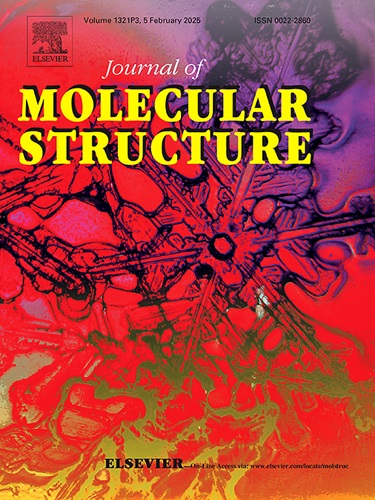Exploring solid-state supramolecular architectures of pyrimidine-based Ag-1D coordination polymers: Experimental observations and theoretical insights
IF 4
2区 化学
Q2 CHEMISTRY, PHYSICAL
引用次数: 0
Abstract
Two new Ag(I) complexes (1 and 2) with pyrimidine ligands were synthesized, and their single crystals were grown using the slow evaporation method. The study explores the synergistic role of hydrogen bonding and CH⋯π interactions in the supramolecular assembly of these pyrimidine complexes, integrating insights from single-crystal X-ray crystallography and Density Functional Theory (DFT) calculations. In both complexes, each Ag(I) ion is coordinated to three nitrogen atoms, forming a wavy 1D coordination polymer supported by hydrogen bonds and CH⋯π interactions. Additionally, the complexes exhibit an intricate hydrogen-bonding network involving lattice perchlorate anions, which connects the units into a 2D supramolecular polymer with cavities. The 2D conformational differences in the crystalline state are influenced by the dihedral angles between the planes of Ag-bridged pyrimidine ring and the tolyl/methoxyphenyl rings, resulting from the presence of methyl/methoxy functional groups in the ligands. DFT analysis provided a deeper understanding of the self-assembly mechanisms in the solid-state structures of the complexes, supporting experimental results. Moreover, DFT results imply that the coordination polymers formed by these complexes should have pronounced thermodynamic stability and could be active in redox reactions acting as good electron acceptors.
探索基于嘧啶的Ag-1D配位聚合物的固态超分子结构:实验观察和理论见解
合成了两个新的嘧啶配体Ag(I)配合物(1和2),并采用慢蒸发法制备了它们的单晶。该研究探索了氢键和CH⋯π相互作用在这些嘧啶配合物的超分子组装中的协同作用,整合了单晶x射线晶体学和密度泛函理论(DFT)计算的见解。在这两种配合物中,每个Ag(I)离子与三个氮原子配位,形成由氢键和CH⋯π相互作用支撑的波浪形1D配位聚合物。此外,配合物表现出复杂的氢键网络,涉及晶格高氯酸盐阴离子,将单元连接成具有空腔的二维超分子聚合物。由于配体中存在甲基/甲氧基官能团,银桥嘧啶环与甲基/甲氧基苯基环平面之间的二面角影响了结晶态的二维构象差异。DFT分析对配合物固态结构中的自组装机制有了更深入的了解,支持了实验结果。此外,DFT结果表明,由这些配合物形成的配位聚合物应该具有明显的热力学稳定性,并且可以作为良好的电子受体在氧化还原反应中活跃。
本文章由计算机程序翻译,如有差异,请以英文原文为准。
求助全文
约1分钟内获得全文
求助全文
来源期刊

Journal of Molecular Structure
化学-物理化学
CiteScore
7.10
自引率
15.80%
发文量
2384
审稿时长
45 days
期刊介绍:
The Journal of Molecular Structure is dedicated to the publication of full-length articles and review papers, providing important new structural information on all types of chemical species including:
• Stable and unstable molecules in all types of environments (vapour, molecular beam, liquid, solution, liquid crystal, solid state, matrix-isolated, surface-absorbed etc.)
• Chemical intermediates
• Molecules in excited states
• Biological molecules
• Polymers.
The methods used may include any combination of spectroscopic and non-spectroscopic techniques, for example:
• Infrared spectroscopy (mid, far, near)
• Raman spectroscopy and non-linear Raman methods (CARS, etc.)
• Electronic absorption spectroscopy
• Optical rotatory dispersion and circular dichroism
• Fluorescence and phosphorescence techniques
• Electron spectroscopies (PES, XPS), EXAFS, etc.
• Microwave spectroscopy
• Electron diffraction
• NMR and ESR spectroscopies
• Mössbauer spectroscopy
• X-ray crystallography
• Charge Density Analyses
• Computational Studies (supplementing experimental methods)
We encourage publications combining theoretical and experimental approaches. The structural insights gained by the studies should be correlated with the properties, activity and/ or reactivity of the molecule under investigation and the relevance of this molecule and its implications should be discussed.
 求助内容:
求助内容: 应助结果提醒方式:
应助结果提醒方式:


